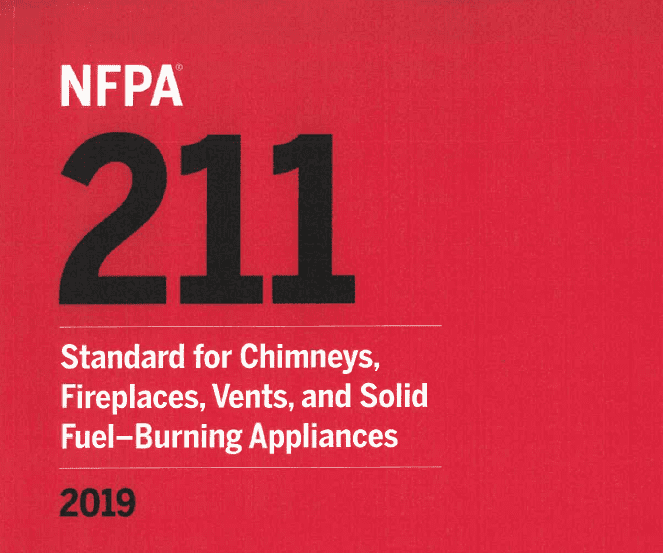Quick Breakdown of the NFPA 211 Standards
December 1, 2022
Key Sections’ Summary from the NFPA 211 (2019 – Latest Edition)

Chapter 1: Administration
-
- Scope: This chapter outlines the application of the NFPA 211 standard, which covers the design, installation, maintenance, and inspection of chimneys, fireplaces, venting systems, and solid fuel-burning appliances.
- Purpose: The main goal of this standard is to ensure the safe removal of waste gases and reduce fire hazards associated with the construction and installation of these systems.
- Retroactivity: The standard generally applies to new installations but can be applied retroactively if deemed necessary by the authority having jurisdiction.
- Equivalency: Allows for alternative methods of construction if they are proven to be equivalent to those prescribed in the standard.
Chapter 2: Referenced Publications
-
- This chapter lists the various NFPA standards and other publications that are referenced within NFPA 211. These documents are considered part of the standard and are necessary for understanding the complete requirements.
Chapter 3: Definitions
-
- General Definitions: Provides definitions for terms used throughout the standard. These definitions ensure that all users of the document have a common understanding of key terms.
- NFPA Official Definitions: Includes definitions like “Approved,” “Authority Having Jurisdiction,” “Labeled,” and “Listed,” which are important for understanding the requirements and recommendations within the standard.
Chapter 4: General Requirements
-
- Sizing and Draft: Covers the requirements for ensuring that chimneys and vents are properly sized to handle the waste gases produced by connected appliances.
- Caps and Spark Arresters: Discusses the design and installation of chimney caps and spark arresters to prevent the entry of rain, snow, animals, and sparks that could ignite a fire.
Chapter 5: Selection of Chimney and Vent Types
-
- Chimney Types: Identifies the three basic chimney types—factory-built, masonry, and unlisted metal—and provides guidelines for selecting the appropriate type based on the appliance and fuel type.
- Chimney or Vent Selection: Provides detailed criteria for selecting the correct chimney or vent type based on the type of appliance, fuel used, and flue gas temperature.
Chapter 6: Factory-Built Chimneys and Chimney Units
-
- Type and Installation: Specifies the types of factory-built chimneys and the requirements for their installation.
- Sizing and Use: Details how to size these chimneys to ensure they meet the needs of the appliances they serve, and outlines the appropriate uses for different types of factory-built chimneys.
Chapter 7: Masonry Chimneys
-
- General Requirements: Provides the construction requirements for masonry chimneys, including materials, dimensions, and clearances from combustible materials.
- Clearances: Discusses the required clearances between masonry chimneys and combustible materials to prevent fire hazards.
Chapter 8: Unlisted Metal Chimneys (Smokestacks) for Nonresidential Applications
-
- General Requirements: Covers the construction and installation requirements for unlisted metal chimneys used in nonresidential applications.
- High-Heat Appliances: Provides additional requirements for metal chimneys used with high-heat appliances, ensuring they can safely handle higher temperatures.
Chapter 9: Chimney Connectors and Vent Connectors
-
- Materials and Installation: Specifies the materials that can be used for chimney and vent connectors and provides guidelines for their installation, including clearances and length limitations.
Chapter 10: Vents
-
- Types and Uses: Describes the different types of vents and their appropriate uses, based on the appliances they serve.
- Termination: Discusses the proper termination height for vents to ensure safe operation and adequate draft.
Chapter 11: Fireplaces
-
- Factory-Built and Masonry Fireplaces: Provides requirements for the installation and construction of both factory-built and masonry fireplaces, including hearth extensions and combustion air ducts.
Chapter 12: Masonry Heaters
-
- Listed and Unlisted Heaters: Details the requirements for both listed and unlisted masonry heaters, including clearances from combustibles.
Chapter 13: Solid Fuel–Burning Appliances
-
- Installation and Clearances: Outlines the installation requirements for solid fuel-burning appliances and specifies the necessary clearances to prevent fire hazards.
Chapter 14: Maintenance
-
- Annual Inspection: Recommends annual inspections of chimneys, vents, and solid fuel-burning appliances to ensure they are in good condition and operating safely.
- Cleaning and Repairs: Discusses methods for cleaning and repairing these systems, as well as how to handle evidence of damage or malfunction.
Chapter 15: Inspection of Existing Chimneys
-
- Types of Inspections: Defines the different levels of chimney inspections (Level I, II, and III) and provides guidelines for when each type should be performed.
- Level I, II, and III Inspections: Details the scope and purpose of each inspection level, from a basic visual inspection to a more detailed assessment involving specialized tools and techniques.
This summary provides an overview of the main sections of NFPA 211 – 2019, giving a clear understanding of its structure and the key areas as Nexus Chimney Services works diligently to cover during all chimney and fireplace inspections for homes throughout the Raleigh-Durham region.




